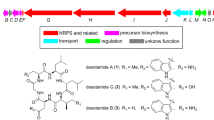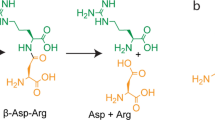Abstract
d-Serine, an important neurotransmitter, also contributes to bacterial adaptation and virulence in humans. It was reported that Pseudomonas aeruginosa PAO1 can grow on d-serine as the sole nitrogen source, and growth was severely reduced in the dadA mutant devoid of the d-alanine dehydrogenase with broad substrate specificity. In this study, the dsdA gene (PA3357) encoding a putative d-serine dehydratase was subjected to further characterization. Growth on d-serine as the sole source of nitrogen was retained in the ∆dsdA mutant and was abolished completely in the ∆dadA and ∆dadA-∆dsdA mutants. However, when complemented by dsdA on a plasmid, the double mutant was able to grow on d-serine as the sole source of carbon and nitrogen, supporting the proposed biochemical function of DsdA in the conversion of d-serine into pyruvate and ammonia. Among d- and l-amino acids tested, only d-serine and d-threonine could serve as the substrates of DsdA, and the Km of DsdA with d-serine was calculated to be 330 μM. Comparative genomics revealed that this cryptic dsdA gene was highly conserved in strains of P. aeruginosa, and that most strains of Pseudomonas putida possess putative dsdCAX genes encoding a transcriptional regulator DsdC and a d-serine transporter DsdX as in enteric bacteria. In conclusion, this study supports the presence of a cryptic dsdA gene encoding a functional d-serine dehydratase in P. aeruginosa, and the absence of dsdA expression in response to exogenous d-serine might be due to the loss of regulatory elements for gene activation during evolution.



Similar content being viewed by others
References
Anfora AT, Haugen BJ, Roesch P, Redford P, Welch RA (2007) Roles of serine accumulation and catabolism in the colonization of the murine urinary tract by Escherichia coli CFT073. Infect Immun 75(11):5298–5304. doi:10.1128/IAI.00652-07
Bruckner H, Haasmann S, Friedrich A (1994) Quantification of d-amino acids in human urine using GC–MS and HPLC. Amino Acids 6(2):205–211. doi:10.1007/BF00805848
Bruckner H, Hausch M (1993) Gas chromatographic characterization of free d-amino acids in the blood serum of patients with renal disorders and of healthy volunteers. J Chromatogr 614(1):7–17
Cava F, de Pedro MA, Lam H, Davis BM, Waldor MK (2011) Distinct pathways for modification of the bacterial cell wall by non-canonical d-amino acids. EMBO J 30(16):3442–3453. doi:10.1038/emboj.2011.246
Cava F, Lam H, de Pedro MA, Waldor MK (2011) Emerging knowledge of regulatory roles of d-amino acids in bacteria. Cell Mol Life Sci 68(5):817–831. doi:10.1007/s00018-010-0571-8
Chou HT, Hegazy M, Lu CD (2010) l-Lysine catabolism is controlled by l-arginine and ArgR in Pseudomonas aeruginosa PAO1. J Bacteriol 192(22):5874–5880. doi:10.1128/JB.00673-10
Cosloy SD, McFall E (1973) Metabolism of d-serine in Escherichia coli K-12: mechanism of growth inhibition. J Bacteriol 114(2):685–694
Farinha MA, Kropinski AM (1990) Construction of broad-host-range plasmid vectors for easy visible selection and analysis of promoters. J Bacteriol 172(6):3496–3499
Friedman M (1991) Formation, nutritional value, and safety of d-amino acids. Adv Exp Med Biol 289:447–481
Friedman M (1999) Chemistry, nutrition, and microbiology of d-amino acids. J Agric Food Chem 47(9):3457–3479
Gallegos MT, Schleif R, Bairoch A, Hofmann K, Ramos JL (1997) Arac/XylS family of transcriptional regulators. Microbiol Mol Biol Rev 61(4):393–410
Haas D, Holloway BW, Schambock A, Leisinger T (1977) The genetic organization of arginine biosynthesis in Pseudomonas aeruginosa. Mol Gen Genet 154(1):7–22
Hashimoto A, Oka T (1997) Free d-aspartate and d-serine in the mammalian brain and periphery. Prog Neurobiol 52(4):325–353
He W, Li C, Lu CD (2011) Regulation and characterization of the dadRAX locus for d-amino acid catabolism in Pseudomonas aeruginosa PAO1. J Bacteriol 193(9):2107–2115. doi:10.1128/JB.00036-11
He W, Li G, Yang CK, Lu CD (2014) Functional characterization of the dguRABC locus for d-Glu and d-Gln utilization in Pseudomonas aeruginosa PAO1. Microbiology 160(Pt 10):2331–2340. doi:10.1099/mic.0.081141-0
Huang Y, Nishikawa T, Satoh K, Iwata T, Fukushima T, Santa T, Homma H, Imai K (1998) Urinary excretion of d-serine in human: comparison of different ages and species. Biol Pharm Bull 21(2):156–162
Imai K, Fukushima T, Santa T, Homma H, Huang Y, Sakai K, Kato M (1997) Distribution of free d-amino acids in tissues and body fluids of vertebrates. Enantiomer 2(3–4):143–145
Ito T, Takahashi K, Naka T, Hemmi H, Yoshimura T (2007) Enzymatic assay of d-serine using d-serine dehydratase from Saccharomyces cerevisiae. Anal Biochem 371(2):167–172. doi:10.1016/j.ab.2007.07.030
Lam H, Oh DC, Cava F, Takacs CN, Clardy J, de Pedro MA, Waldor MK (2009) d-Amino acids govern stationary phase cell wall remodeling in bacteria. Science 325(5947):1552–1555. doi:10.1126/science.1178123
Li C, Lu CD (2009) Arginine racemization by coupled catabolic and anabolic dehydrogenases. Proc Natl Acad Sci USA 106(3):906–911. doi:10.1073/pnas.0808269106
Roesch PL, Redford P, Batchelet S, Moritz RL, Pellett S, Haugen BJ, Blattner FR, Welch RA (2003) Uropathogenic Escherichia coli use d-serine deaminase to modulate infection of the murine urinary tract. Mol Microbiol 49(1):55–67
Schweizer HP (1991) Escherichia–Pseudomonas shuttle vectors derived from pUC18/19. Gene 97(1):109–121
Suzuki C, Murakami M, Yokobori H, Tanaka H, Ishida T, Horiike K, Nagata Y (2011) Rapid determination of free d-serine with chicken d-serine dehydratase. J Chromatogr B 879(29):3326–3330. doi:10.1016/j.jchromb.2011.07.028
Yang Z, Lu CD (2007) Functional genomics enables identification of genes of the arginine transaminase pathway in Pseudomonas aeruginosa. J Bacteriol 189(11):3945–3953. doi:10.1128/JB.00261-07
Yao X, He W, Lu CD (2011) Functional characterization of seven gamma-glutamylpolyamine synthetase genes and the bauRABCD locus for polyamine and beta-alanine utilization in Pseudomonas aeruginosa PAO1. J Bacteriol 193(15):3923–3930. doi:10.1128/JB.05105-11
Acknowledgments
This work was supported by National Science Foundation MCB 0950217.
Author information
Authors and Affiliations
Corresponding author
Rights and permissions
About this article
Cite this article
Li, G., Lu, CD. The Cryptic dsdA Gene Encodes a Functional d-Serine Dehydratase in Pseudomonas aeruginosa PAO1. Curr Microbiol 72, 788–794 (2016). https://doi.org/10.1007/s00284-016-1021-0
Received:
Accepted:
Published:
Issue Date:
DOI: https://doi.org/10.1007/s00284-016-1021-0




